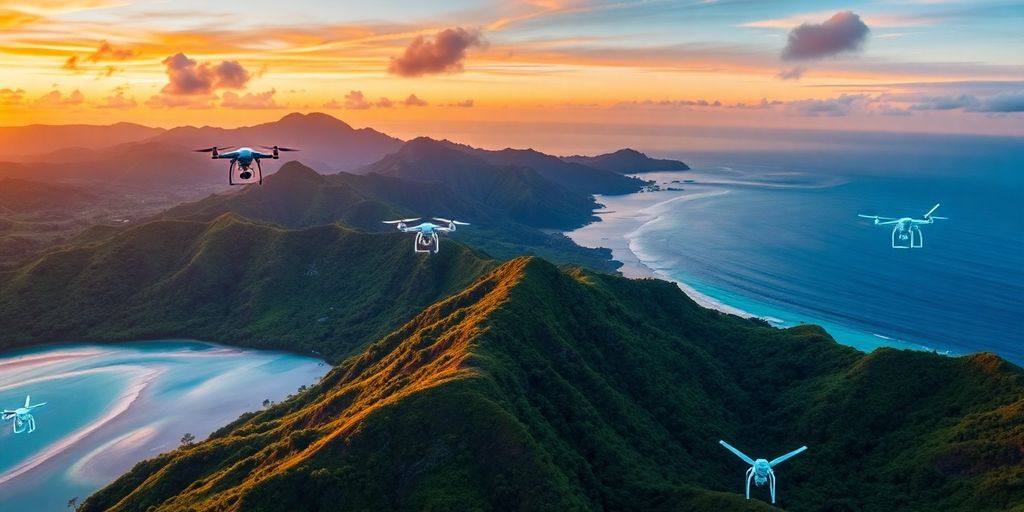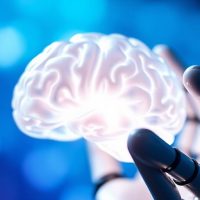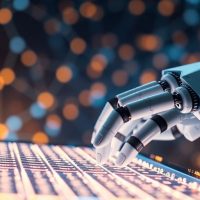Hawaii is stepping into the future with artificial intelligence (AI) making waves across various sectors. From healthcare to agriculture and tourism, AI is reshaping how businesses operate and interact with the community. This article explores how Hawaii’s unique environment and culture are paving the way for innovative AI applications, while also addressing the challenges and opportunities that come with this technological shift.
Key Takeaways
- Hawaii’s AI scene includes universities, startups, and government initiatives working together.
- AI is transforming local industries like healthcare, agriculture, and tourism, enhancing efficiency and experiences.
- Educational programs in Hawaii are focusing on AI to prepare the next generation of tech professionals.
- The state is looking at AI for sustainable energy and environmental conservation, making it a leader in eco-friendly tech.
- Challenges like talent retention and infrastructure need to be addressed for Hawaii’s AI growth to continue.
Hawaii’s AI Landscape
Hawaii’s AI scene is pretty interesting. It’s not Silicon Valley, but it’s got its own vibe, mixing academic research with new companies and government support. The state’s unique location and culture mean AI can grow in ways that fit Hawaii specifically.
Key Players in Hawaii’s AI Ecosystem
There are a few main groups pushing AI forward in Hawaii. Universities, research centers, and startups are all involved. The University of Hawaii is a big one, offering classes and doing research in machine learning and language processing. As more AI experts are needed, these schools are helping to train them.
- University of Hawaii
- Local AI startups
- Research institutions
Government and Private Sector Support
The Hawaiian government sees AI as important and is backing projects to help it grow. They’re funding research and starting educational programs. The goal is to make Hawaii a leader in AI. It’s great to see the government supporting AI development.
Unique Geographic Opportunities
Hawaii’s location gives it special chances to use AI. For example, AI can help with:
- Managing resources
- Dealing with climate change
- Improving agriculture
Hawaii can use AI to solve problems that are specific to the islands. This could mean better ways to protect the environment or improve tourism. It’s all about finding AI solutions that fit the local needs.
Applications of AI in Local Industries

AI is starting to change how things are done in Hawaii, especially in some key industries. It’s not just about fancy tech; it’s about making things work better for everyone.
AI in Healthcare
AI is making a real difference in healthcare here. Think about it: getting quicker diagnoses and more personalized treatments. It’s not just about seeing a doctor online, it’s about using AI to analyze medical images and patient data to catch things earlier and create treatment plans that fit each person. This means better care and hopefully better outcomes for patients.
- AI helps predict disease outbreaks, so hospitals can get ready.
- It assists doctors in making faster, more accurate diagnoses.
- AI can personalize treatment plans based on individual patient data.
AI is helping to make healthcare more efficient and effective, which is a big deal for a place like Hawaii where access to specialized care can sometimes be a challenge. It’s about bringing better healthcare to more people.
AI in Agriculture
Agriculture is super important in Hawaii, and AI is stepping in to help farmers out. It’s all about using resources smarter and growing better crops. AI systems can keep an eye on weather, soil conditions, and even spot pests before they become a big problem. This means farmers can make smarter choices about when to plant, water, and harvest. AI technologies are really helping to make farming more sustainable.
- AI monitors environmental conditions to optimize crop yields.
- It predicts weather patterns to help farmers plan.
- AI detects pests and diseases early, reducing the need for pesticides.
AI in Tourism
Tourism is huge for Hawaii, and AI is helping to make the experience even better for visitors. Imagine getting personalized recommendations for activities or having a virtual tour guide that knows exactly what you’re interested in. That’s what AI can do. It’s about creating experiences that are unique and memorable, which keeps people coming back. AI is being used to create more immersive and customized experiences for tourists.
- AI provides personalized recommendations for activities and attractions.
- It powers virtual tour guides that offer customized experiences.
- AI helps manage crowds and optimize visitor flow.
AI Research and Education in Hawaii
It’s pretty cool to see how Hawaii is stepping up its game in AI research and education. The local universities are really getting into it, and there’s a growing connection between what they’re doing in the classroom and what’s happening in the real world. It’s not just about learning the theory; it’s about applying AI to solve problems that are specific to the islands.
University Programs and Initiatives
The University of Hawaii is definitely leading the charge here. They’ve got some solid computer science programs with specializations in AI, machine learning, and robotics. Students are getting hands-on experience, which is super important. It’s not just about reading textbooks; they’re actually building stuff and working on projects that could have a real impact. Plus, they’re contributing to ongoing research, which is pretty awesome.
Collaboration Between Academia and Industry
What’s really interesting is how the universities are teaming up with tech companies. It’s not just a one-way street; they’re working together to conduct research and find practical uses for AI. The Hawaii AI Research Center is a great example of this. They’re partnering with businesses to develop AI solutions that are tailored to Hawaii’s unique challenges, like sustainable agriculture and renewable energy. It’s all about finding ways to use AI to make things better for the local community.
Emerging AI Research Centers
There’s a growing number of AI research centers popping up around Hawaii. These centers are focusing on different areas, from environmental conservation to healthcare. They’re bringing together experts from different fields to tackle complex problems using AI. It’s still early days, but it’s exciting to see the potential for these centers to become hubs of innovation and drive the future of AI in Hawaii.
It’s great to see Hawaii investing in AI research and education. It’s not just about keeping up with the latest trends; it’s about finding ways to use AI to address the unique challenges and opportunities that the islands face. By fostering collaboration between academia and industry, Hawaii can create a thriving AI ecosystem that benefits the entire community.
Future of Hawaii AI: 2025-2030 Predictions

AI-Powered Wave Energy
Hawaii is making big moves in renewable energy, and AI is set to play a huge role. By 2030, we can expect to see AI significantly boosting our wave energy capabilities. The goal is to power a substantial portion of our coastal communities using wave energy, all optimized by smart AI systems.
- AI algorithms will be used to predict wave patterns with greater accuracy, maximizing energy capture.
- Advanced sensors and machine learning will optimize the positioning and operation of wave energy converters.
- This initiative will create new jobs in marine robotics and sustainable energy management.
Wave energy has always been a promising resource for Hawaii, but its variability has been a challenge. AI offers the potential to smooth out these fluctuations and make wave energy a reliable source of power.
Advancements in AI-Driven Agriculture
Agriculture is another area where AI is poised to make a significant impact. Imagine drones that speak Hawaiian, helping farmers monitor their crops! That’s the kind of innovation we’re looking at. These advancements will not only improve efficiency but also help preserve cultural heritage. AI ethics will be important as we move forward.
- AI-powered drones will monitor crop health, detect diseases early, and optimize irrigation.
- Natural language processing will enable farmers to interact with AI systems in Hawaiian, preserving indigenous language and knowledge.
- Precision agriculture techniques will reduce water and fertilizer use, promoting sustainability.
Sustainable Tourism Innovations
Tourism is vital to Hawaii, but it also presents environmental challenges. AI can help us create a more sustainable tourism industry, minimizing its impact on our natural resources. We’re talking about smart systems that manage resources, reduce waste, and enhance the visitor experience. The shift away from big data is important here.
- AI-powered systems will optimize energy consumption in hotels and resorts.
- Smart waste management systems will reduce landfill waste and promote recycling.
- Personalized recommendations and virtual tours will encourage visitors to explore less-crowded areas, reducing pressure on popular sites.
Here’s a look at how AI is already helping with coral reef protection:
| Year | Protected Area (sq mi) | Disease Detection Rate |
|---|---|---|
| 2020 | 120 | 68% |
| 2024 | 450 | 92% |
Challenges and Opportunities in Hawaii’s AI Development
Hawaii’s AI scene is on the rise, but it faces some real hurdles. At the same time, each problem opens the door to new ways for the islands to stand out. Below, we look at three main areas where progress is needed—and where fresh ideas can have big payoffs.
Talent Retention Issues
One major hurdle is keeping skilled AI workers on the islands. Many experts end up chasing higher pay and bigger tech scenes on the mainland. But that challenge can spark local solutions:
- Mentorship networks linking students with seasoned pros
- Flexible work arrangements that fit island life
- Specialized tracks in island-focused AI areas
As Frontier Women in Digital like Susan Oh show, role models help build a strong, homegrown talent pool.
Building a skilled workforce here means more than just training—it takes real chances, local pride, and work that fits our way of life.
Infrastructure and Investment Needs
Hawaii needs better tech bones to support growing AI labs and startups. High-speed networks, data centers, and modern hardware all cost money. Here’s a quick look:
| Need | Current Status | Suggested Investment |
|---|---|---|
| High-speed Wi-Fi | Spotty coverage | $50M over 3 years |
| Data centers | Few and small | $75M expansion fund |
| GPU clusters | Limited availability | $30M grant program |
• Public–private partnerships can share the load.
• A clear plan helps investors see the chance for returns.
• Pilot projects prove what works before scaling up.
Ethical Considerations in AI
As AI tools spread, the islands must keep an eye on fair use and privacy. Small communities can feel big impacts if data goes wrong.
- Set clear rules on how personal data is used.
- Create review boards with local voices.
- Offer easy-to-understand privacy guides to everyone.
Hawaii has both hurdles and real chances to shape an AI scene that fits its way of life.
Impact of AI on Hawaii’s Environment
AI in Environmental Conservation
AI is becoming a game-changer in how we protect Hawaii’s natural resources. It helps us analyze huge amounts of environmental data quickly and accurately. This means we can spot problems earlier and come up with better solutions. For example, AI can monitor water quality, track endangered species, and even help restore damaged ecosystems. It’s like having a super-powered assistant dedicated to keeping Hawaii beautiful.
- Monitoring coral reef health using image recognition.
- Predicting and preventing forest fires with weather pattern analysis.
- Optimizing water usage in agriculture to conserve resources.
AI offers tools to understand and manage Hawaii’s environment more effectively. It’s not a replacement for human effort, but a way to amplify our impact and make conservation efforts smarter and more targeted.
Monitoring Climate Change Effects
Climate change is a big deal for Hawaii, and AI is stepping up to help us understand what’s happening. AI algorithms can analyze climate data to track rising sea levels, monitor changes in temperature, and predict extreme weather events. This information is important for Maui’s smart city initiatives and helps communities prepare for the future. It also helps policymakers make informed decisions about how to reduce the impact of climate change.
Preserving Biodiversity with Technology
Hawaii is home to many unique plants and animals, and AI is playing a role in protecting them. AI-powered tools can identify and track endangered species, monitor their habitats, and even help prevent poaching. For example, AI can analyze camera trap images to identify animals and estimate their populations. This information helps conservationists make better decisions about how to protect Hawaii’s biodiversity. AI can also help with personalized recommendations for tourists, guiding them to enjoy Hawaii’s natural beauty responsibly.
Here’s a simple example of how AI could be used to monitor endangered bird populations:
| Feature | AI Application |
|---|---|
| Bird Sounds | Identify species from their calls |
| Image Analysis | Track bird movements and nesting sites |
| Habitat Mapping | Predict suitable habitats based on climate data |
Community Engagement and AI Awareness
Public Perception of AI
How people in Hawaii feel about AI is super important. It’s not just about the tech itself, but how it fits into our culture and daily lives. A recent survey showed that 63% of the community approves of using AI in ways that preserve and promote Hawaiian culture. That’s a pretty good start, but there’s still work to do in making sure everyone understands what AI is and what it can do – both good and bad. We need to have open conversations about AI ethics and how it impacts our values.
Educational Outreach Programs
To help people understand AI better, there are some cool programs popping up. Schools are starting to include AI in their lessons, and there are workshops for adults too. One example is voice-activated tutors launching in 20 schools, aiming to cut learning time by 30%. These programs aren’t just about teaching people how to code; they’re about showing how AI can be used in different fields, from healthcare to agriculture. The goal is to make AI less scary and more accessible to everyone.
- AI workshops for teachers
- Community college AI courses
- Online resources for self-learning
Local AI Events and Workshops
There are more and more events happening around the islands where people can learn about AI and talk to experts. These events are a great way to see what’s happening in the local AI scene and connect with others who are interested in the field. For example, the Hawaii Center for AI is working on community-driven AI guidelines to ensure cultural sensitivity. These events help to build a community around AI and make sure that everyone has a voice in how it’s developed and used. It’s all about making sure AI benefits everyone in Hawaii, not just a few.
It’s important to remember that AI is a tool, and like any tool, it can be used for good or bad. By getting involved in the conversation and learning about AI, we can help shape its future in Hawaii and make sure it aligns with our values.
Looking Ahead: The Future of AI in Hawaii
As we wrap up our exploration of AI in Hawaii, it’s clear that the islands are on the brink of something exciting. With advancements in technology, local businesses, and educational institutions are stepping up to embrace AI in ways that fit the unique needs of the community. From healthcare improvements to smarter farming techniques, the potential is vast. Sure, there are challenges, like attracting talent and ensuring ethical use of AI, but the opportunities are equally significant. As Hawaii continues to innovate and adapt, it will be fascinating to see how AI shapes the islands’ future. So, keep an eye on this space—Hawaii’s journey with AI is just beginning!
Frequently Asked Questions
What is AI and how does it work?
AI, or Artificial Intelligence, is technology that allows machines to think and learn like humans. It helps computers perform tasks that normally need human intelligence, such as understanding language and making decisions.
How is AI being used in Hawaii?
In Hawaii, AI is used in many areas, including healthcare to improve patient care, agriculture to help farmers grow crops better, and tourism to create personalized experiences for visitors.
What are the main challenges for AI growth in Hawaii?
One big challenge is finding skilled workers. Many experts in AI move to bigger cities for jobs, so Hawaii needs to focus on keeping talent and building a strong local workforce.
What role do schools play in Hawaii’s AI development?
Schools, especially the University of Hawaii, are important for teaching students about AI. They offer programs that help students learn the skills needed to work in AI fields.
How does AI impact Hawaii’s environment?
AI helps monitor and protect Hawaii’s environment by analyzing data to track endangered species, assess water quality, and understand climate change effects.
What is the future of AI in Hawaii?
The future of AI in Hawaii looks bright. With more investment in education and technology, AI is expected to grow in areas like renewable energy and sustainable tourism.

Peyman Khosravani is a seasoned expert in blockchain, digital transformation, and emerging technologies, with a strong focus on innovation in finance, business, and marketing. With a robust background in blockchain and decentralized finance (DeFi), Peyman has successfully guided global organizations in refining digital strategies and optimizing data-driven decision-making. His work emphasizes leveraging technology for societal impact, focusing on fairness, justice, and transparency. A passionate advocate for the transformative power of digital tools, Peyman’s expertise spans across helping startups and established businesses navigate digital landscapes, drive growth, and stay ahead of industry trends. His insights into analytics and communication empower companies to effectively connect with customers and harness data to fuel their success in an ever-evolving digital world.










